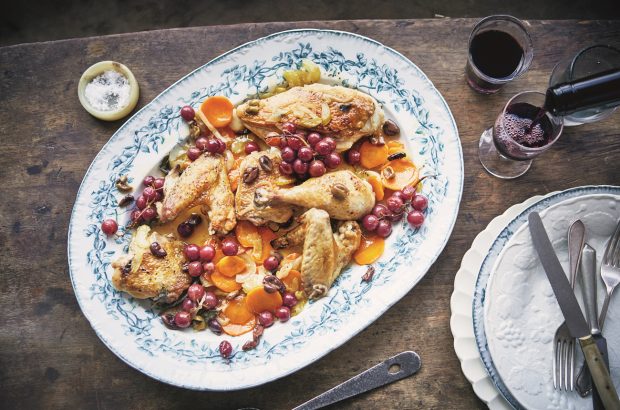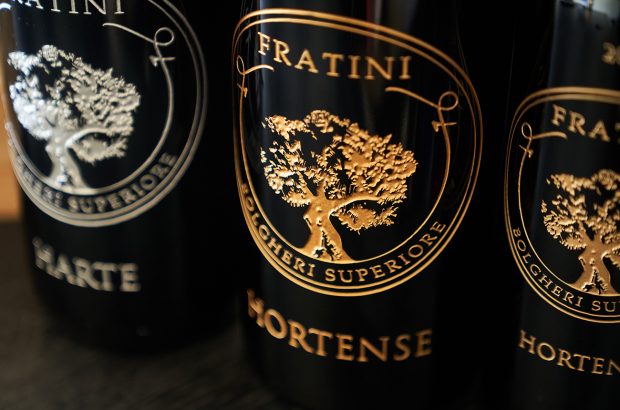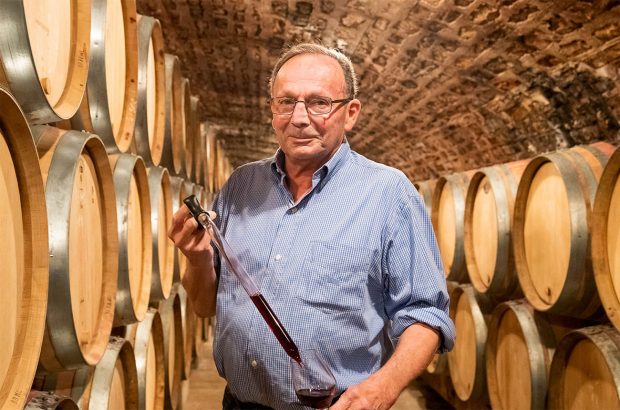Stags Leap District
- The next serious piece of business on the agenda is to market California wine by specific appellation, not by grape variety.
- Most of the approved appellations, known as American Viticultural Areas, presently have no well defined identity and focus.
- By the year 2000, almost all of the grapes picked in the district will come from post-phylloxera vines.
- The new vintages of Stags Leap District Cabernet are seen as ‘comprising rich texture, depth of flavour, and layers of classic black cherry fruit’.
Over the last several months, a few movers and shakers in California, such as Tim Mondavi of Robert Mondavi Winery and Augustin Huneeus of Franciscan Estates, have been suggesting to their fellow vintners that the next serious piece of business on the agenda is to market California wine by specific appellation, not by grape variety. The varietal approach which has served California vintners so well is now working against them as growers from elsewhere have taken up the practice and varietal wines from all over the world are now flooding into the Golden State and the rest of North America.
Switching the marketing and promotional emphasis over to appellations (and reprogramming the way wine growers think) will not be easy. One good reason is that most of the approved appellations, known as American Viticultural Areas (AVAs), presently have no well defined identity and focus. First set in motion in the early 1970s, the AVA system only lays down territorial boundaries: what goes on within those borders in terms of varieties planted, yields and the type of wine produced is unrestricted.
As a result, most AVAs have a wide range of products and images and thereby tend to confuse the consumer. Among the many AVA’s that have become watered down in this way is the Napa Valley. In mid-March, the Robert Mondavi Winery hosted a symposium to examine the present state of the appellation system there. Everyone agreed there is work to be done, and plans were made to pick up the discussions next year.
Never known to wait around for others, Mondavi is actually moving on to the next level, which is to focus considerable attention on so-called ‘district wines’. Already involved in developing the Carneros District as a centre for Pinot Noir and Chardonnay, Mondavi has now started marketing its first Cabernet Sauvignon from the Stags Leap District.
The company owns 162 hectares (ha) in the area and has put considerable time and money into redeveloping its holdings. Farmed with sustainable agricultural practices, the vineyards are laid out using dense vine planting and vertical training methods. Cabernet Sauvignon, Merlot and Sauvignon Blanc, the primary varieties, are now all on a variety of rootstocks, with numerous clones of each in use. This new viticultural programme, part of the response to phylloxera, is site specific: the soils determine which rootstock, clone, and trellis system is used for each variety planted in any given location.
With almost every producer making similar dramatic changes to Mondavi, the Stags Leap District may well be the first California appellation to come out of major replanting with an entirely new look. And with the 1997 harvest, most wine-makers brought in significant quantities of fruit from their new plantings. By the year 2000, almost all of the grapes picked in the district will come from post-phylloxera vines.
The district
Small by California standards, Stags Leap District is approximately 0.5km wide and 1km long. It was revived in the modern era by Nathan Fay, who planted 28.5ha of Cabernet Sauvignon as early as 1961. Today, a dozen wine producers are situated in the area, including Stag’s Leap Wine Cellars, owned by the Winiarski family, and Stag’s Leap Winery, now owned by Beringer Estates. Clos du Val settled there in 1972, and in 1978 both Shafer and Pine Ridge established wineries.
Long before it became an approved AVA in 1989, the Stags Leap District had earned a reputation for growing fine Cabernet Sauvignon: as far back as 1976 a Cabernet Sauvignon from Stag’s Leap Wine Cellars finished first at Steven Spurrier’s famous Paris tasting, beating several of the top Bordeaux châteaux. The post-phylloxera Stags Leap District is now almost all Cabernet Sauvignon and Merlot; producers have pulled out many hectares of Chardonnay, Riesling and Chenin Blanc. Chimney Rock Winery, for example, which once grew Sauvignon Blanc and Chardonnay, replanted its entire 30.5ha vineyard with Cabernet Sauvignon, Merlot and a little Cabernet Franc and Petit Verdot. Other wineries like Shafer, Clos du Val, Pine Ridge and Silverado Vineyards added more Cabernet and Merlot when they replanted.
According to Nancy Andrus of Pine Ridge Winery: ‘Because of improved grape growing methods, Stags Leap District wines now truly capture a sense of place because the fruit quality is much better.’ As Chimney Rock’s winemaker, Doug Fletcher, explains: ‘Phylloxera not only forced us to replant our vineyard with varieties better suited to the area, but it also allowed us to adopt a new viticultural philosophy based on the concept of a balanced vine. This method works by increasing stress on the vines so as to produce mature, well structured wines with ripe flavours and better tannins.
The difference in the wines, beginning with the 1995 vintage, is dramatic and seems clearly attributable to improved vineyard management.’
Even those, like Warren Winiarski of Stag’s Leap Wine Cellars, who were not forced by phylloxera to move fast, made changes in order to avoid being left behind at the curve. Winiarski has also applied new viticultural techniques to achieve balanced vines: ‘About 10 years ago, we tried to fine-tune our approach by trimming canes and using other vineyard techniques, but we really weren’t clear on the balanced vine concept.’
Except for one small block, Winiarski’s 28.5ha Nathan Fay Vineyard, which he acquired in 1986, has been completely replanted. Winiarski points out that it and other new vineyards now have combinations of rootstocks and clones matched to soil types: ‘Because in our minds, we now imagine how to grow the fruit for balance before we actually plant the vine.’ The one constant before and after phylloxera is the favourable location of the region. Situated along the Silverado Trail east of the Napa River and five miles north of the town of Napa, Stags Leap District is a special place with a special climate.
Shaped like a funnel, the area is surrounded by low lying hills on the west and by mountains to the east. The funnel’s broad end is open to the south, and this arrangement encourages a cooling inflow of air from the San Pablo Bay during the growing season. The Palisades, jagged outcroppings of the Vaca mountain range which lies to the east of the region, reflect the heat of the sun off their rocks and on to the vineyards, causing temperatures to rise quickly during the day. Some vintners add that cool air coming down from the mountains and the hills means lower night-time temperatures.
Producing Cabernet Sauvignon from Rutherford and Howell Mountain as well as Stags Leap District, Gary Andrus of Pine Ridge Winery is unable to maintain complete neutrality. He has even been known to declare Stags Leap to be America’s premier Cabernet Sauvignon area. According to Andrus: ‘The District is unique among small appellations because it is marked by well-drained soils and because the weather has such a great influence on it. You have the cooling affect of the fog in the morning and light wind in the afternoon which make for a cool season and slow ripening of the fruit.’
The Stags Leap style
Despite any doubts experts may have had in the past about an identifiable aroma and flavour profile, Stags Leap District is now well on its way to becoming one of the most recognisable and distinctive appellations in California. Clos du Val’s Bernard Portet defines the regional style of Cabernet Sauvignon as a ’round, soft middle with an attractive long finish’. The wines tend to be broader and softer than those originating from Rutherford. According to Doug Shafer of Shafer Vineyards, who works with hillside grown fruit, the wines display ‘pronounced fruit flavours such as cherry and cassis and are united by their silky-chocolatey character and soft tannins’. Words like ‘expansive’, ‘well-knit’ and ‘viscous’ are frequently used by Gary Andrus, who sees the new vintages of Stags Leap District Cabernet as ‘comprising rich texture, depth of flavour, and layers of classic black cherry fruit’.
The major players
S Anderson Vineyard is primarily known for sparkling wines: its Brut and Blanc de Noirs have been excellent lately. Residing in the Stags Leap District, S Anderson has put together a string of brilliant, if limited production, Cabernet Sauvignons from grapes grown in the nearby Richard Chambers Vineyard. The same vineyard is also used to produce a deep, built-to-last Merlot.
Best wine: Cabernet Sauvignon, Richard Chambers Vineyard.
Chimney Rock Winery falls in the southern part of the appellation and now focuses squarely on Cabernet Sauvignon. It may be California’s most-improved winery in 1998. All three of the estate’s 1995 wines: Cabernet Sauvignon, Reserve Cabernet Sauvignon, and the Meritage blend, Elevage, show elegance and finesse.
Best wine: 1994 Reserve Cabernet, 1994 Elevage, 1995 Stags Leap District
Hartwell Vineyard is currently offering 1995 Cabernet from its four hectare Sunshine Vineyard, on a slope opposite Stag’s Leap Wine Cellars. This 100% Cabernet wine is given 21 months ageing in new Franch oak and has played to rave reviews. With beautiful dense fruit and ripe cherry and cassis flavours supported by just the right touch of toasty oak, the 1995 Hartwell has quickly become one of a handful of collectors’ Cabernets. Hartwell also has one hectare recently planted with the Grace clone of Cabernet Sauvignon.
Best wine: 1995 Cabernet Sauvignon
Pine Ridge Winery has 10ha planted with Cabernet Sauvignon and other Bordeaux varieties in Stags Leap. The 1993 reveals some young vine simplicity, both the 1994 and Stags Leap District Cabernets are rich and distinctive, but also have considerable depth and subtle power which suggest fine ageing potential.
Best wine: 1995 Cabernet Sauvignon and 1996 Chardonnay, Stags Leap District
Robert Mondavi Winery has 162ha in Stags Leap, between Yountville and Napa. Most consists of Cabernet and Merlot, but there are also areas of Sauvignon Blanc and a few Italian varieties. In addition to a Stags Leap Sauvignon Blanc offering bright, generous fruit, Mondavi recently came out with a Cabernet Sauvignon which is a knock-out. Only a few hundred cases were made, but clearly Cabernet Sauvignon is part of Mondavi’s plan for the area.
Best wines: 1995 Cabernet Sauvignon, 1996 Sauvignon Blanc
Shafer Vineyards now has 21.5ha around the winery, planted mostly with Cabernet Sauvignon, Merlot and a patch of Sangiovese. Making Cabernet Sauvignon, Merlot and a special Cabernet named Hillside Select, Shafer may have emerged in the 1990s as the star of the area (and of California). It certainly has been on a hot streak since 1990, and even its wines from 1993, a difficult vintage, are rich, concentrated and top-drawer. The 1994s are fine, but the 1995s, especially the Hillside Select, may be the best ever.
Best wine: Hillside Select Cabernet Sauvignon (1993, 1994, 1995), Merlot (1994, 1995)
Silverado Vineyards has about 40ha, most of it newly developed. Always among the top producers of fruit-filled Cabernet and Merlot in the 1980s, Silverado returned to making Cabernet from the estate’s Disney Vineyard in 1995. It has a rich, silky texture and black cherry fruit, but with more layers of flavour than the early vintages.
Best wine: 1995 Cabernet Sauvignon
Robert Sinskey Vineyards is in the northern corner of the region and while making most of its wines from its Carneros holdings, it has two hectares planted to Cabernet and blending cousins in Stags Leap. The only wine from this appellation is labelled SLV Claret, a blend of Cabernet, Cabernet Franc and Merlot.
Best wine: 1994 SLV Claret
Stag’s Leap Wine Cellars put the district on the map and has been the key player for years. Each vintage it offers a SLV Cabernet Sauvignon from the original vineyard near the winery and a Fay Vineyard Cabernet from the adjacent vineyard. In exceptional vintages it bottles a limited amount of Cask 23 Cabernet Sauvignon.
Best wine: 1994 SLV and Fay Vineyard Cabernet Sauvignons
Stag’s Leap Winery is now part of Beringer Estates. With 36.5ha planted primarily to Cabernet Sauvignon, Merlot and Petite Sirah, the winery returned to form in 1994 with nicely structured Cabernet Sauvignon and Merlot. Although labelled Napa Valley, the three reds derive their character from Stags Leap. The Petite Sirah, made from old vines, is in a class by itself.
Best wine: Cabernet Sauvignon (1994, 1995)
Steltzner Vineyards is run by Dick Steltzner who has long been one of Napa’s best vineyard developers. Established in the late 1960s, his own 20ha vineyard now has a variety of clones and is part of the region’s new viticultural look. Steltzner Cabernets are rich and powerful, but still possess the region’s hallmark black cherry fruit and supple texture. They age well.
Best wine: Cabernet Sauvignon (1995, 1994, 1992)
For Stags Leap District as a whole the best years for Cabernet Sauvignon are:
1978, 1981, 1984, 1985, 1987, 1990, 1992, 1993, 1994 and 1995.
For Merlot, the vintages to watch out for are:
1987, 1989, 1991, 1992, 1993, 1994 and 1995.














